Learn how to cook quinoa to fluffy perfection with a few simple steps. Use this protein-packed nutritional powerhouse in a wide variety of recipes.
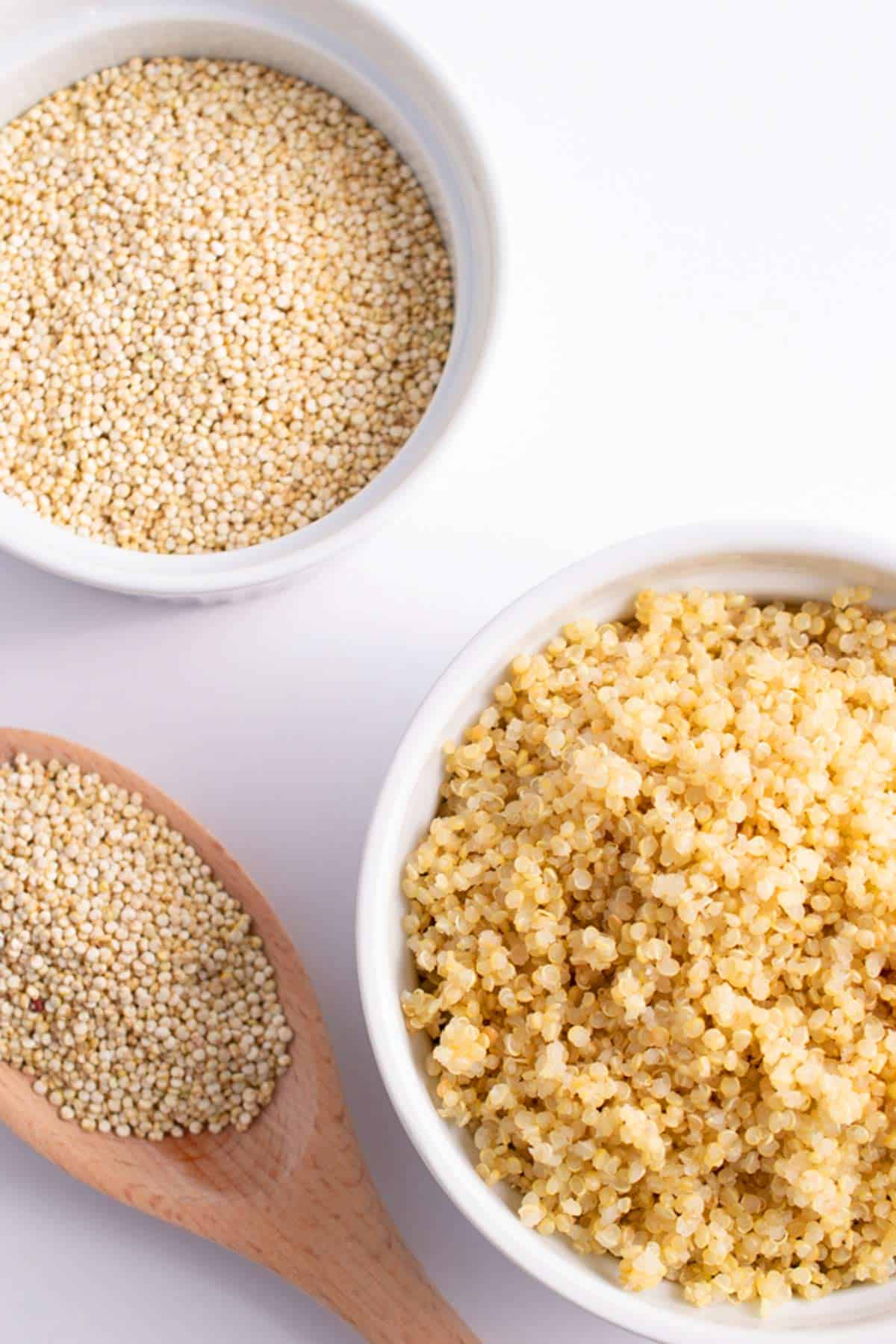
Where did quinoa come from? In the past decade, quinoa has created a buzz in the health and culinary world. You know what I mean.
Fitness gurus emphasize quinoa’s protein punch, nutritionists proclaim its health benefits, and celebrity chefs demonstrate how tasty it is.
In addition, NASA scientists have experimented with quinoa for long space flights. And the United Nations highlights its potential to alleviate global hunger.
It has many champions, and for good reasons. I recommend eating it regularly, which is why learning how to cook quinoa is important.
If you are on the lookout for the best ways to cook staple foods, this tutorial is for you. After you have cooked your first batch of quinoa, you can use it in both sweet and savory dishes.
RELATED: You can also read how to cook black beans and how to cook brown rice for cooking tips to prepare these whole foods.
Jump to:
- What Does Quinoa Taste Like?
- Most Popular Types of Quinoa
- Tip for Cooking Quinoa
- How to Cook Quinoa on the Stove
- How to Make Instant Pot Quinoa
- How to Cook Quinoa in a Rice Cooker
- Frequently Asked Questions About Quinoa
- How to Store Cooked Quinoa
- Can you Freeze Quinoa?
- Can You Reheat Quinoa?
- Cool Quinoa Facts
- Recipe
- Easy Quinoa Recipes
- The History of Quinoa
- Quinoa’s Rise in Popularity
- Comments
What Does Quinoa Taste Like?

Quinoa (commonly pronounced “keen-wah”) tastes like a mild and slightly nutty grain with more chew than you would expect for such tiny seeds.
Yes, quinoa is a wheat-free seed, not a grain. More accurately, it is a pseudocereal or pseudograin because it is derived from a seed plant. In contrast, wheat and oats come from grasses.
Uncooked quinoa seed has a natural coating containing bitter saponins. If your quinoa tastes bitter, the saponin coating is still there.
Most quinoa commercial producers in the United States pre-wash it to remove this coating. Your quinoa package should be labeled pre-washed if it has been.
However, if you taste bitterness, remove the saponins and bitterness yourself.
It is easy to do. Simply rinse quinoa with water in a fine-mesh strainer until the water runs clear. Then cook, sprout, or grind the quinoa into flour.
Quinoa cooks by absorption. This means that the seed absorbs the water as it cooks and becomes fluffy.
Most Popular Types of Quinoa
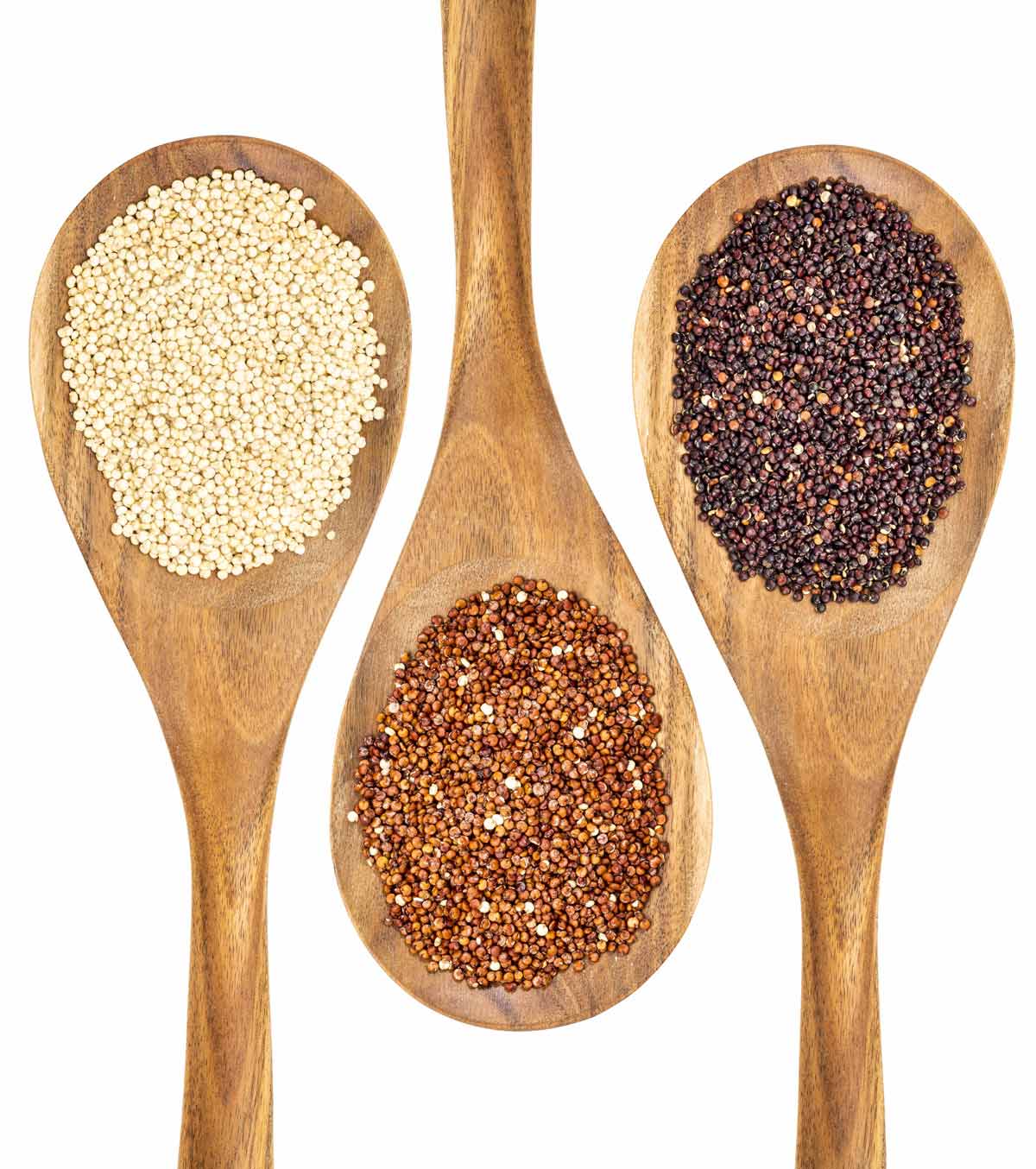
You can find quinoa in various colors, including white, red, and black quinoa. Are there any differences in the varieties of quinoa other than the color?
All cooked quinoa is gluten-free and rich in vitamins, minerals, fiber, and protein. However, there are slight differences in the flavor and cooking time for the variety of colors of quinoa.
- White quinoa has the mildest flavor and the shortest cooking time. Be careful not to overcook, or it may not keep its shape.
- Red quinoa wins the contest for the best color. You might choose this variety because it is attractive in a quinoa salad or grain bowl.
It also has slightly higher antioxidants than the other colors of quinoa. Why? Because red quinoa has betalains (antioxidants) that result in the red color.
- Black quinoa has the longest cooking time, but only by a couple of minutes on the stove. It has a mildly nutty earthy flavor.
Most grocery stores sell white quinoa. Many also sell red quinoa or rainbow quinoa, which is a mix of the three colors. Black quinoa can be harder to find.
Tip for Cooking Quinoa

Many elements influence the quality of cooked quinoa. Factors ranging from the type of pan used to the ratio of quinoa to water can impact the end result.
Listed below are some of the most crucial components that determine the outcome of your cooked quinoa.
- Has your quinoa been pre-washed? Most commercial quinoa producers pre-wash quinoa to remove the bitter saponins.
However, if your quinoa has not been pre-washed, rinse it under cool water until the water runs clear. Or soak it in a bowl of cold water. Rinsed quinoa no longer tastes bitter when cooked.
- What type of pan are you using? The kind of pan you use makes a difference in the finished pot of quinoa. I find that high-quality pans that conduct heat will work significantly better than cheap pans found in discount stores.
Less sticking, clumping, and mushy quinoa result when using a high-quality pan.
In addition, wide shallow pans (such as frying pans) cook the quinoa the most evenly. Try this type of pan for your next quinoa batch. Make sure the pan has a lid.
- Did you toast the quinoa? You may prefer toasted quinoa. It adds an interesting nutty flavor. Toasting the quinoa also removes any bitterness that may have been left behind by some lingering saponins.
- How much water did you add? If you rinse the quinoa before cooking, there will be extra moisture in the seeds. As a result, you should add less water.
The standard quinoa water ratio is 2 cups water to 1 cup quinoa when cooking it on the stovetop. However, if you rinse the quinoa, add 2 tablespoons less water for best results to compensate for the added moisture in the grains.
- Did you let the quinoa rest covered and off the heat after cooking? Resting the quinoa off heat is essential to making the best quinoa. Rest the quinoa off heat and covered for 5 to 10 minutes. Residual cooking results when the trapped steam finishes cooking the quinoa more evenly.
- Does your cooking liquid match your recipe? Water always works. But for extra flavor built into the cooking process, use chicken or vegetable broth.
You can also add a small amount of fresh herbs for flavor.
How to Cook Quinoa on the Stove
I like my quinoa grains nutty, fluffy, yet distinct with a bit of chew. To achieve this taste and texture, follow these steps.

- TOAST the quinoa in a wide and shallow medium pot, like a frying pan. Make sure the pan has a lid.
- ADD water to the pan and a pinch of salt after the quinoa is toasted.
- BRING the water to a boil.
- After the water starts boiling, COVER the pan with the lid and reduce the heat. Cook at a low simmer for 15 to 20 minutes, or until all the excess water is absorbed. The cooked quinoa will resemble tiny spirals.
- REST the pan off the heat for 5 minutes to allow the quinoa to steam and finish cooking evenly.
- FLUFF with a fork.
- SERVE warm or cold.
How to Make Instant Pot Quinoa
It is a good idea to cook raw quinoa in a pressure cooker. It is one of my favorite ways to prepare it.
It is truly the only foolproof way to prepare quinoa because the cooking environment is controlled.
It is easy to batch cook quinoa as part of your weekly meal prep. Or to double the recipe for a lot of people coming to dinner.
- USE 2 cups of liquid for every cup of quinoa.
- COOK on high pressure for 1 minute. (It takes about 5 minutes to reach pressure.)
- Let it DEPRESSURIZE on its own for 10 to 15 minutes. Then release manually.
- FLUFF and serve.
How to Cook Quinoa in a Rice Cooker
You can get perfect quinoa in a rice cooker. And it is easy to do.
- SPRAY the rice cooker pan to prevent the quinoa from sticking.
- USE a 1:2 ratio of quinoa to water (double the amount of water per quinoa). For example, 1 cup of quinoa and 2 cups of liquid.
- CHOOSE the white rice setting if your rice cooker has one. It cooks for about 30 minutes. Let it rest for about 5 minutes after it is done. Then fluff with a fork and serve.
Frequently Asked Questions About Quinoa
In the United States, Quinoa is commonly pronounced “keen-wah.”
Make quinoa taste good by toasting it and cooking it in vegetable or chicken broth. Season with herbs, spices, or other flavorings. Don’t forget to salt it too.
• If the quinoa tastes bitter, rinse it before cooking it. Most quinoa packages sold in the United States have been pre-rinsed to remove the bitter-tasting saponins. However, if you buy quinoa that has not been pre-rinsed, you must rinse it yourself before cooking it.
• Add sweet or savory toppings. Cranberries, raisins, apples, and dried apricots are excellent sweet toppings. Tomatoes, red onions, chickpeas, and cucumbers are great savory toppings.
About ⅔ cup of dry quinoa cooked in 1⅓ cup of cooking liquid will yield 2 cups of cooked quinoa.
Cook in the Instant Pot for 1 minute. Allow it to depressurize naturally. Fluff and serve.
Quinoa seeds naturally have saponins in their coating. Saponins taste bitter and, as a result, deter birds from snacking on them.
Typically, quinoa is eaten cooked or ground into flour before being cooked or baked. However, you can also sprout quinoa and eat it raw.
How to Store Cooked Quinoa
Does cooked quinoa need to be refrigerated? Cooked quinoa needs to be refrigerated, just as you would chill cooked white rice. After quinoa is cooked, it will last in the fridge for up to a week.
After the quinoa is cooked, allow it to cool completely. Place the cooled quinoa in an airtight container and store it in the refrigerator.
Can you Freeze Quinoa?
The best part about making quinoa is making a large batch and then freezing half.
- Cool it to room temperature.
- Store the quinoa in individual serving containers so you can pull out just what you need.
- To freeze a whole batch, place the cold quinoa in a freezer-safe zip-top bag. Freeze for 1 hour.
Remove the bag from the freezer and scrunch and move the bag around to break up the quinoa that is sticking together. Return the bag to the freezer and freeze it completely.
Now you should be able to pull out a cup or so at a time without having to thaw the whole bag.
Can You Reheat Quinoa?
It is safe to reheat quinoa. There are several ways to reheat it.
- Microwave quinoa covered for 30 to 90 seconds, depending on the amount being reheated.
- Reheat quinoa on the stove. Use a wide, shallow pan (like a frying pan) over medium-low heat with 1 to 2 tablespoons of water for every cup of quinoa.
Cool Quinoa Facts
Nearly everyone enthusiastically recommends quinoa. There are lots of health benefits of quinoa. Check out these characteristics of cooked quinoa:
- A cup of quinoa has as much protein as a cup of milk. That is 8 grams of protein.
- Quinoa is a complete protein. As a complete protein, quinoa contains all nine essential amino acids (including lysine, rarely found in plants). These essential amino acids are critical for tissue growth and repair.
- Rich in B vitamins (B1, B2, B6, and folate) and vitamin E.
- Quinoa is packed with calcium, magnesium, manganese, iron, copper, and zinc.
- Rich in dietary fiber.
- Gluten-free.
- Low glycemic index food.
- Complex carbohydrate.
Did you like this post? Then let's be social. FOLLOW ME on INSTAGRAM and PINTEREST to keep up with the latest happenings.
Recipe
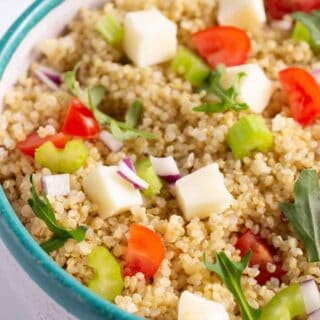
How to Cook Quinoa
Ingredients
- 1 cup dry quinoa
- 2 cups water or broth chicken or vegetable broth are the best
- ¼ to ½ teaspoon of salt
Instructions
- Stove Top Instructions
- HEAT a skillet or other wide, shallow pan over medium heat.
- ADD the quinoa to hot, dry pan.
- TOAST the quinoa for 5 to 7 minutes over medium-low heat.
- STIR occasionally until the quinoa smells nutty and begins to pop and crackle.
- POUR the water or broth and salt into the pan after the quinoa is toasted.
- BRING the liquid to a boil.
- COVER the pan with the lid after it begins to boil.
- COOK for 15 to 20 minutes, or until the liquid is all absorbed.
- REST the pan off the heat with the lid on for 5 minutes to allow the quinoa to finish by steaming.
- FLUFF quinoa with a fork.
- SERVE warm or cold alone as a side dish or mixed in a salad or casserole.
- Pressure Cooker Instructions
- POUR the quinoa, salt, and water into the pressure cooker pot.
- PRESSURE COOK on high for 1 minute. (It will take about 5 minutes to pressurize.)
- LET the pressure cooker naturally release pressure. If you are in a hurry, let the pressure naturally release for about 15 minutes before manually releasing the pressure.
- FLUFF with a fork and serve.
- Rice Cooker Instructions
- SPRAY the rice cooker pan to prevent the quinoa from sticking.
- POUR the quinoa, salt, and water into the rice cooker pot.
- CHOOSE the white rice setting if your rice cooker has one. It cooks for about 30 minutes. Let it rest for about 5 minutes after it is done. Then fluff with a fork and serve.
Notes
Nutrition
Easy Quinoa Recipes
Some of the best quinoa recipes are simple. Nothing wrong with that. It makes a tasty breakfast protein bowl, a healthy salad lunch, and a delicious casserole dinner.
- Try a side dish made with quinoa, olive oil, and fresh herbs. It is all you need to serve with cooked chicken.
- Quinoa black bean salad. Part quinoa, part black bean with lots of fresh veggies, this is one of the healthy quinoa recipes you are after.
- Substitute quinoa in any recipe with whole grains.
- Try 30 minutes Southwest Chipotle Kale Quinoa Bowl. It might become one of your new favorite quinoa recipes.
What is your favorite way to eat quinoa? Comment below and let me know.
The History of Quinoa
Ancient South Americans grew quinoa over 5,000 years ago. Although originally fed to livestock, the Incan people cultivated it for human consumption about 3,000 years ago.
It originated in the Andes Mountains regions in Peru and Bolivia, and most of the agriculture production is still there.
The ancient Incan people of South America believed quinoa was sacred. It was an important food source and was sustainable. They referred to it reverently as “The Mother Grain”.
Alexander Von Humboldt (a Latin American geographer) said that quinoa was to the Incan people what “wine was to the Greeks, wheat to the Romans, cotton to the Arabs”.
So, how did an ancient grain become so popular in the United States?
Quinoa’s Rise in Popularity
In 1993, NASA commissioned a study on the use of quinoa as a suitable food for long-term space missions. Scientists selected it as an experimental crop for NASA’s Controlled Ecological Life Support System.
NASA liked quinoa because it had high protein, contained all the essential amino acids, was versatile and easy to use, and it was promising when grown hydroponically in a greenhouse.
NASA got the world’s attention.
The United Nations Food and Agricultural Organization called quinoa a “super crop” because of its nutritional value, its storage ability, and its potential to resolve food shortages and global hunger.
The United Nations General Assembly declared 2013 the International Year of Quinoa, hoping to draw attention to all of quinoa’s benefits.
The attention worked. Quinoa has become so popular in the United States in the last 10 years that it has tripled in price since 2006 because of the high demand.
In fact, quinoa typically costs 3 times more than rice and 9 times more than wheat.

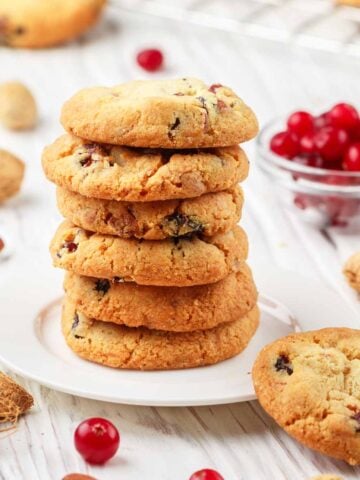
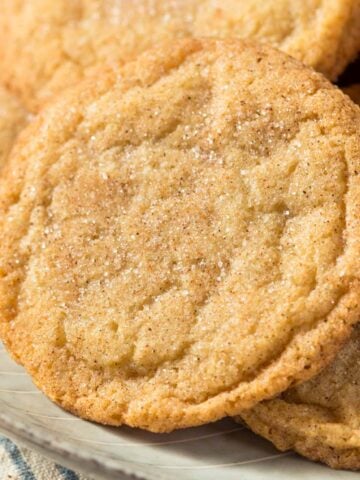
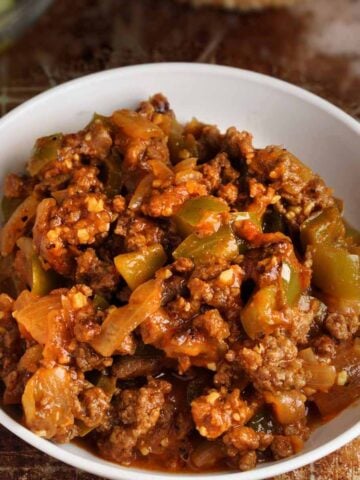
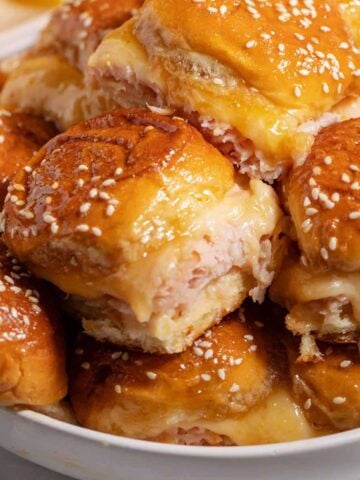
Comments
No Comments